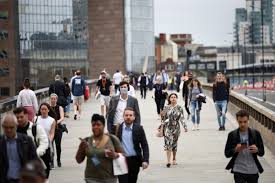UK employment hits record high but the economy is still short 1 million workers

London: The number of people in work in the United Kingdom has climbed above its pre-pandemic level for the first time, reaching a record high. But that hasn’t plugged worker shortages that are pushing up wages and making Britain’s inflation problem harder to solve.
Employment hit a record 33.1 million between February and April, with increases in both the number of employees and self-employed workers, the Office for National Statistics said.
The sectors that saw the biggest job gains were health and social care, followed by hospitality, according to ONS director of economic statistics Darren Morgan.
Employment in the United Kingdom has recovered more slowly than in any other major economy since the pandemic, according to the UK Institute for Employment Studies. And Tuesday’s jobs figures will serve as good news for the government, which unveiled a raft of measures in March to encourage parents, retirees and those with disabilities or in poor health back into work.
But labor shortages are still holding back economic growth and forcing wages higher, adding to inflationary pressures. Average regular pay, which excludes bonuses, increased 7.2% during the February-April quarter compared with the same period in 2022, the ONS said.
This is the fastest rise on record, apart from the period when the figures were distorted by the pandemic, Morgan noted.
Economists said the rise in pay partly reflected an increase of around 10% in the national minimum wage in April, but that the data would still add to the Bank of England’s concerns about inflation becoming ingrained in the economy.
Financial markets are already pricing in further interest rate hikes to tame price rises, with the yield on UK government bonds — or gilts — maturing in two years’ time now above the highs reached during a sharp selloff in the fall.
Gilt yields, which move in the opposite direction to prices, soared in late September after investors rejected an announcement by the government of then-Prime Minister Liz Truss that it would slash taxes and ramp up borrowing in a bid to boost growth. They feared the plan would push up already-high inflation and put public debt on an unsustainable path.
Although plans by the current finance minister, Jeremy Hunt, to cut government debt have helped calm financial markets, investors are now betting the UK’s stubborn inflation problem will lead to a fresh surge in borrowing costs.
“Overall, the loosening in the labor market appears to have stalled in April and wage growth remained very strong,” said Capital Economics UK economist Ashley Webb. “This supports our view that the Bank will raise interest rates from 4.5% to 4.75% next Thursday, and eventually to a peak of 5.25%.”
Pay rises, albeit strong, continue to lag inflation. Consumer prices rose 8.7% in April compared with a year ago, outpacing inflation in Europe and the United States. Food inflation remained above 19% — near a 45-year high — hitting poor households the hardest because they spend more of their available income on food.
There is still a surplus of unfilled jobs, particularly in industries such as construction, retail and agriculture.
That’s despite the number of vacancies falling for the 11th consecutive period, as employers held back on recruitment in the face of economic uncertainty, the ONS said.
In the March-to-May period, total vacancies dipped below 1.1 million, but remained 250,000 above the level in March 2020 before the pandemic hit.
Ill health continues to be a major driver of worker shortages, with those not in work due to “long-term sickness” rising to a new record above 2.5 million.





